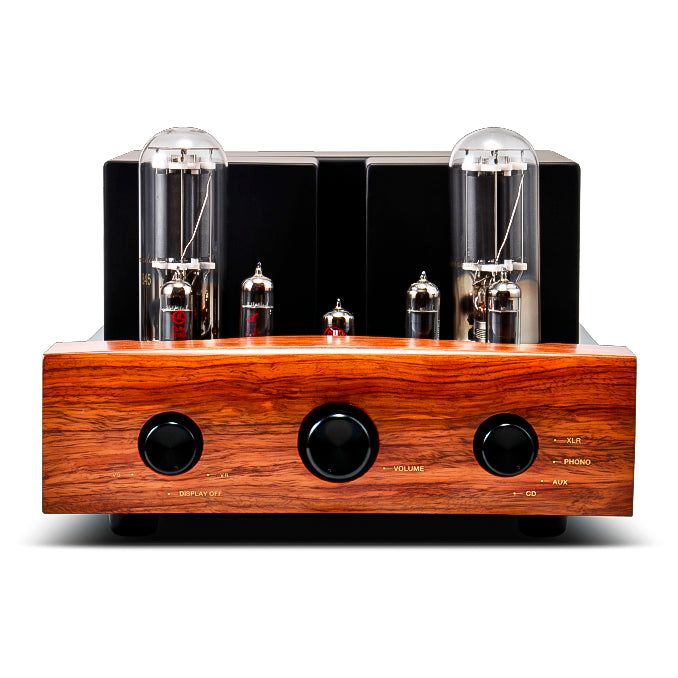Listening to music is your hobby, and some people are probably working hard on vacuum tube amplifiers as an option to enjoy higher quality music, but what is actually a vacuum tube? You may have doubts and concerns about what to do after-sales maintenance while using it. This time I've written about after-sales maintenance for vacuum tubes.
Click here for the product page for vacuum tube amplifiers
https://www.exclusive-audio.jp/shop/products/list.php?category_id=32
Click here for the product page for the amplifier shown in the photo.
https://www.exclusive-audio.jp/shop/products/detail.php?product_id=628
Vacuum tubes are light bulb-like components that have been used for decades before the invention of transistors and semiconductors, and are used for many years, which control audio signals and current. In addition, vacuum tubes with the same standard and compatible specifications are manufactured from various manufacturers around the world, and can be replaced with vacuum tubes from different manufacturers than those that came with the amplifier. Are the materials, manufacturing processes, and environment used even for vacuum tubes of the same standard? Each manufacturer has its own characteristics in sound. Therefore, the great attraction of vacuum tube amplifiers is that they can enjoy pursuing the sound they like by replacing them with other manufacturers.
Regarding replacement, pre-tubes, which are responsible for adjusting the disturbed audio signals and delivering them to the power amplifier, can be easily replaced. However, the audio signal sent from the pre-tube is amplified to increase it.output tubeA bias adjustment is required to adjust the amount of current to suit the vacuum tube used. Thankfully, many amplifiers now have self-bias adjustment, eliminating the need for troublesome bias adjustments, making it possible to easily replace the same-model and compatible vacuum tubes.
Even if you have not replaced the vacuum tube, just as the bulb is a consumable product, if you use the vacuum tube for a long period of time, its function will deteriorate and you will need to replace it.
So, when will the lifespan of the vacuum tube be replaced, when and when will it be replaced?
One of the timings is if the tube breaks for some reason. Just like incandescent bulbs, air enters the glass tube, which is in a vacuum state, or the internal lines are broken, making it easy to understand because the amplifier is not operating properly and there is no sound. It's more of an accident than a lifespan.
And the other is lifespan. Vacuum tubes generally last quite long and are said to last around 5,000 hours. If this long, there are almost no regulations such as when to replace it. In fact, many of the vacuum tubes on the market and other products from manufacturers, which are advertised as original products, are unused stock and used items manufactured decades ago, manufactured and used. When used with audio equipment, there are some masterpieces that can produce good sounds even after decades, depending on how they are used. Even so, the deterioration progresses gradually, and as it is a long life, it is likely that people continue to use it without realizing that their performance has already deteriorated.
Unlike the easily visible broken patterns where no sound is produced at all, the symptoms of life expectancy are listening to the sounds, and it's very vague, like there's a bit of noise in the sound...is the sound a little distorted? Maybe it's a little small... If it sounds different from what you remember, then doubt the deterioration and aging of the vacuum tubes lol. It's a bit sloppy, but it's difficult to understand because of the familiarization and changes in the system. For this reason, some amplifiers have a meter that allows you to check the status of the vacuum tube at any time.
Click here for the product page for the amplifier shown in the photo.
https://www.exclusive-audio.jp/shop/products/detail.php?product_id=196
Generally, a change in the mirror surface at the top of the vacuum tube is a symptom of lifespan and deterioration that allows you to see the vacuum tube itself with your eyes. This is a material called getter that adsorbs impurities and other substances to prevent the vacuum inside the vacuum tube, which is applied to part of the back of the glass tube. Due to age and continuous use, these silvery areas may peel off, fade away, and the inside of the vacuum tube may become darker. If these conditions can be visually confirmed, this is the standard that can be determined as the life of a vacuum tube. So, as a guide to your lifespan, check regularly to see if your getter decreases.
Click here for the product page for the amplifier shown in the photo.
https://www.exclusive-audio.jp/shop/products/detail.php?product_id=511
However, there is no need to be very careful about the lifespan, and as mentioned above, you can enjoy the difference in sound quality by replacing the tube with a vacuum tube of the same type or compatible model, and enjoying the difference in sound quality, while occasionally wiping the glass tube from time to time, or using an absolute ethanol or other material to carefully remove dirt when replacing it.
To put it simply, you can enjoy vacuum tube amplifiers as you feel symptoms like the bulbs you use have been using have been getting bad recently, dark, or claps, and you think you have to replace them, so even first-time users should give it a try.





























